Many thanks to Games Workshop for providing us with an advanced preview copy of the new Flesh Eater Courts Army Box for us to review.
Why Play Flesh-eater Courts?
Are you missing the regal knights of old? Wanting Kings and Nobles atop majestic flying(?) steeds charging headlong alongside them? That’s what this army thinks it is. That’s not me trying to be funny, that’s the lore. These monstrous terrors of the night are delusional in the strictest sense; they genuinely believe that they are kings, nobles, knights, courtiers, etc etc etc. This is some of the coolest lore that Age of Sigmar has to offer, and it is well worth digging into.
5 Best Things About The Book
- A new Mortarch
- Delusions
- Priests! In GA Death!
- Reworked summoning
- Bravery bombs
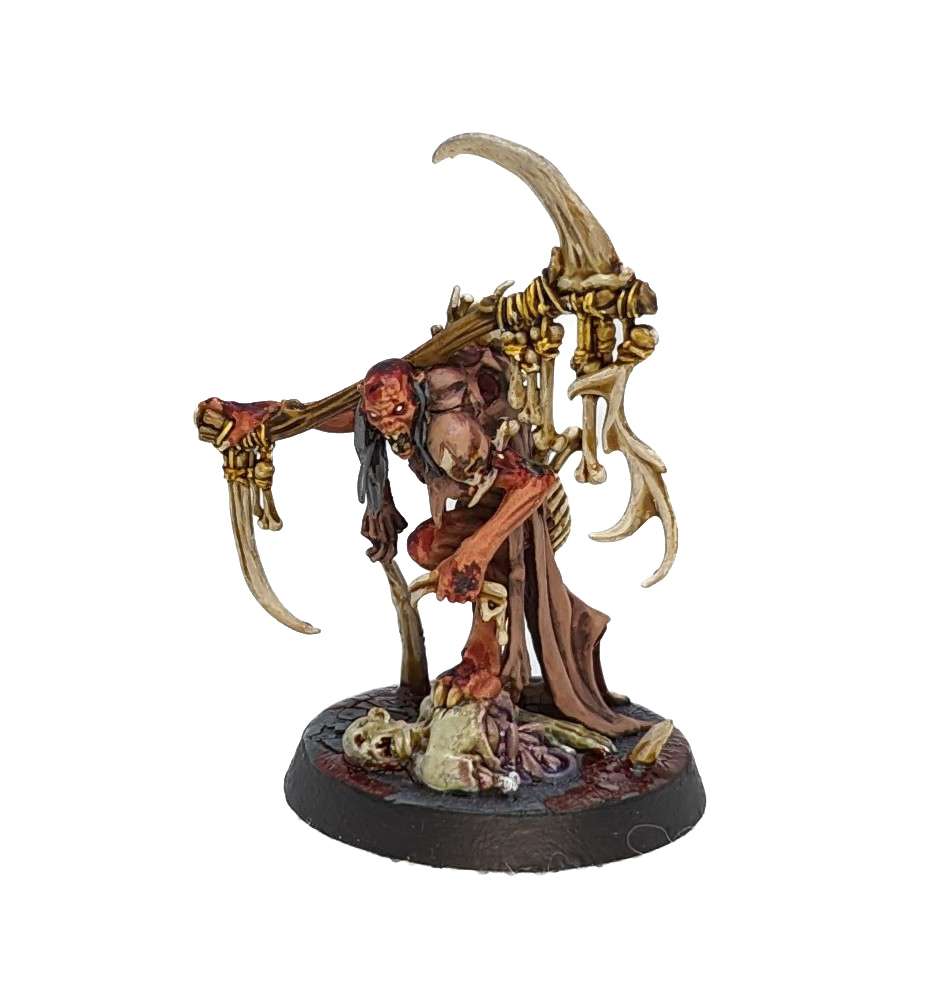
The Rules
Battle Traits
The FEC battle traits have been reworked and have much more depth but thankfully still keep Deathless Courtiers for a 6+ ward. This is fine if unspectacular, though the army does have a few ways of getting a better ward save.
Noble Deeds is the headline new resource-tracking battle trait. At a glance it looks complex but is blessedly fairly simple in play. Each time one of your heroes casts a spell or chants a prayer (yup, priests!) they get a Noble Deed point. In addition, after a hero fights it gets Noble Deed points equal to the number of wounds allocated to enemy units by them (but not by their mount). Each hero caps at a maximum of 6 points at any one time. Noble Deed points fuel a lot of the rest of the FEC allegiance abilities and it can be a delicate balance trying to keep your heroes topped up whilst not getting themselves killed in the process.
Same name, new ability: Feeding Frenzy is now a 12” aura of +1 attack from any FEC hero with 6 Noble Deed points. If you can keep the points up, this is great – FEC have an issue with rend and mediocre to-hit values that demand a weight of attacks to keep the damage up.
Summoning has been totally reworked and is now more in-line with how it works for other non-chaos summoning factions; recycling units and bringing models back at the end of the movement phase.
Muster Guard is an ability that can be done by any Courtier, spending 1 Noble Deed point to bring back a Serf model into a unit within 10”, or 2 points for a Knight. This can be used as many times a turn as you have points – so 6 Serfs or 3 Knights out of a single Courtier. The trick here will be on keeping those points up, Courtiers are not natural spell casters or priests and whilst they can be mean in melee the absolute toughest Courtier is 8 wounds with a 4+ save – they need to be very careful how they pick their fights, so keep alternate methods of generating Noble Deed points on your mind with them. Note also that the range on this isn’t wholly within, so you can toe units back to be within range to regenerate them.
Summon Loyal Subjects is the summoning ability for Abhorrants. It costs 6 Noble Deed points and lets you bring a destroyed unit back at half its original size – more than 9” from enemy units and wholly within 6” of any table edge. You can’t recycle a unit twice but you can use Muster Guard to put models back into the unit up to its original strength (eg. If a unit of 3 Crypt Horrors is killed, you can bring 2 back with Summon Loyal Subjects and then return the third model with Muster Guard). This ability is expensive and has the obvious drawback of immediately losing a Feeding Frenzy you would otherwise have had, but Abhorrants are naturally better at generating Noble Deed points than Courtiers.
Courts of Delusion
This trait gets a fairly major rework and is now a choice that you make in the first battle round after getting CP but before the start of the first turn. You will have full knowledge of who is going first, where everything is set up, etc etc. The choices are:
- The Royal Hunt – +1 to wound for attacks that target a monster is a solid buff when it’s relevant, thankfully you will have perfect knowledge of when it will be worth picking.
- Crusading Army – +1 to run and charge is another solid buff, and a decent all-round pick, especially for an army that can be trying to make a lot of 9” charges.
- Defenders of the Realm – Probably the ‘default’ pick, +1 to save for any unit contesting an objective. You want to be contesting objectives anyway. You don’t have to control the objective and you don’t even need the whole unit on it either.
- The Grand Tournament – A simple +1 to hit for heroes that aren’t your general who make a charge move that turn. There’s too many riders on this to be a competitive choice but is cool and fun if you’re going hero-hammer.
- The Feast Day – Another very solid choice, this makes it so Feeding Frenzy triggers on 4 Noble Deed points rather than 6. This does make a meaningful difference on how likely it is to be up in the early game.
Flesh-eaters get two new Heroic Actions that are both decent but unreliable. Rousing Oration picks a hero and rolls a dice for each other FEC unit wholly within 12” of them, they get a Noble Deed point for every 5+. FEC are an army that wants to cluster within 12” bubbles anyway, and this is a pretty easy win on those early heroic actions that usually go to waste. Meanwhile, Scent of Blood is a 3+ roll to let the hero move d6”, so long as it finishes the move closer to an enemy unit that has wounds allocated to it. You can’t get into combat in the hero phase Khorne-style with this, but it can be a way to get around cheeky redeploys.
Finally there are two unique Monstrous Rampages for Terrorgheists and Zombie dragons. Delectable Appetisers can only target a unit with 2 or fewer wounds and does d3 mortals on a 3+, then heals the monster for every mortal wound caused and not negated. Mostly a worse stomp, but can be useful to nudge damaged models up a bracket. Bloodcurdling Shriek picks an enemy unit and on a 3+ subtracts 2 from their bravery until the end of the turn. Sounds bad, but there are definitely some bravery shenanigans you can get up to with this book.
Command Traits
A lean set of three each for Abhorrants and Courtiers.
For Abhorrants Shadowy Obfuscation is a solid defensive pick, rendering them not visible to enemy units that are more than 12” from them. Most Abhorrants will be benefiting from Look Out, Sir anyway, but this does work on your mounted heroes who are meaningfully weak to early alpha-strike shooting. Otherwise Feverish Scholar is a good pick, giving a +1 to cast/unbind/dispel that goes to +2 if they have 6 Noble Deed points. Master of the Menagerie is the gimmick option, but fine if you’re doing a monster mash thing, as it lets you use Summon Loyal Subjects to bring back a non-hero monster that has been destroyed, with 6 wounds allocated to it.
Courtiers have Stronger in Madness which hands out a flat +2 wounds and also a 5+ ward if they happen to have 6 Noble Deed Points. Fine, but has to compete against the absolute banger that is Cruel Taskmaster – this changes the economy of Muster Guard so that each Knight costs just 1 point and you get 2 Serfs per point spent rather than 1. This doubles the efficiency of your ability to regenerate units and will likely be the default FEC command trait unless you have a specific reason for something else. Savage Beyond Reason is exploding hits in melee. Some of the Courtiers are a bit tasty in a fight, but go and read Cruel Taskmaster again.
Artefacts
Again, these get split out between your Abhorrant and Courtier keywords.
The Grim Garland returns for Abhorrants and still subtracts 2 from the bravery of enemy units within 9”. If you’re doing an Ushoran build, this can start doing a lot of work and is a solid artefact. The Blood-river Chalice is a once per battle 2d3 heal, it’s unexciting but can be triggered in any hero phase, unlike your Abhorrant’s warscroll healing. Heart of the Gargant is another once per battle effect, and hands out +1 attack to the hero and their mount. Not bad on a Terrorgheist wanting to stack as many extra bite attacks as possible.
Courtiers get some really solid options starting with the Medal of Madness, a free command once per battle round that counts the bearer as the general when they issue it. The Flayed Pennant is a 12” aura of free charge re-rolls and Charnel Vestments turn the bearer into a priest. These all rock, but the Vestments open up a way to start generating Noble Deed on a Courtier without them needing to be stuck into combat – so expect to see a lot of Cruel Taskmaster + Charnel Vestment Courtiers.
Spells
Just three of these and we’re into some variable quality, whilst we’re in Andtor you may well want to dip into that spell lore.
- Miasmal Shroud – CV6, 18” range. Pick an enemy unit and roll 6 dice. If you roll two of the same number it does a mortal, three or more is -1 to hit and four or more is -1 to wound. If you roll a 10+, roll 8 dice. The debuffs stack so potentially powerful, but a total gambler’s paradise – this is a low odds spell.
- Deranged Transformation – CV6, 24” range. Pick a friendly unit wholly within range with a wounds characteristic of 7 or less (so nothing Varghulf sized or larger) and they get +2” move and +1 to wound until your next hero phase. If you roll a 10+ you can pick 3 units for this. Uncomplicatedly very good on basically everything it is allowed to target.
- Crimson Victuals – CV6, 18” range. Pings an enemy for d3 mortal wounds and then picks a friendly unit with a wounds characteristic of 1 within 6” of that enemy and brings as many back as wounds caused. On a 10+ it’s a scarier 2d3 mortal wounds. Not spectacular but a fine enough nuke.
Prayers
Actual prayers in a Death faction. Beat again, my still heart.
- Bless This Meal – CV3, range 18”. Pick an enemy unit and for each model you slay, you can heal a wound to a FEC unit within 6” of it. It’s OK, being an offensive prayer with a middling range limits it’s viability in the early game, which is when you want to be getting your prayers off for Noble Deed points.
- The Summerking’s Favour – CV3, range 18”. Picks a friendly hero and gets them an extra Noble Deed point for every model they kill. This feels like a trap option – generating points is good but if you’re killing multiple models you’re likely hitting the cap of 6 points anyway.
- Charnel Conviction – CV3, range 18”. Give a FEC unit wholly within range a 5+ ward. Yes please.
Mount Traits
A table for each flavour of Hero-ridden dragon.
Zombie Dragons can get rend -2 on their decent shooting profile with Baneful Breath. Alternatively, Death from the Skies lets your dragon be set up off the battlefield and arrive from reserves in the usual manner. Venerated Zombie Dragon is your fun monster mash option, and provides an incredibly useful aura of +1 to hit for FEC monsters wholly within 12”.
For Terrorgheists Gruesome Bite predictably lost its rerolls and is now a flat +1 attack for the fanged maw. Horribly Resilient upgrades the hero phase heal to 2d3, which can actually give a decently tanky hero thanks to the options for a 5+ ward available. Morbheg’s Swiftness gives retreat and charge which is good, but probably less consistently useful than the other options here.
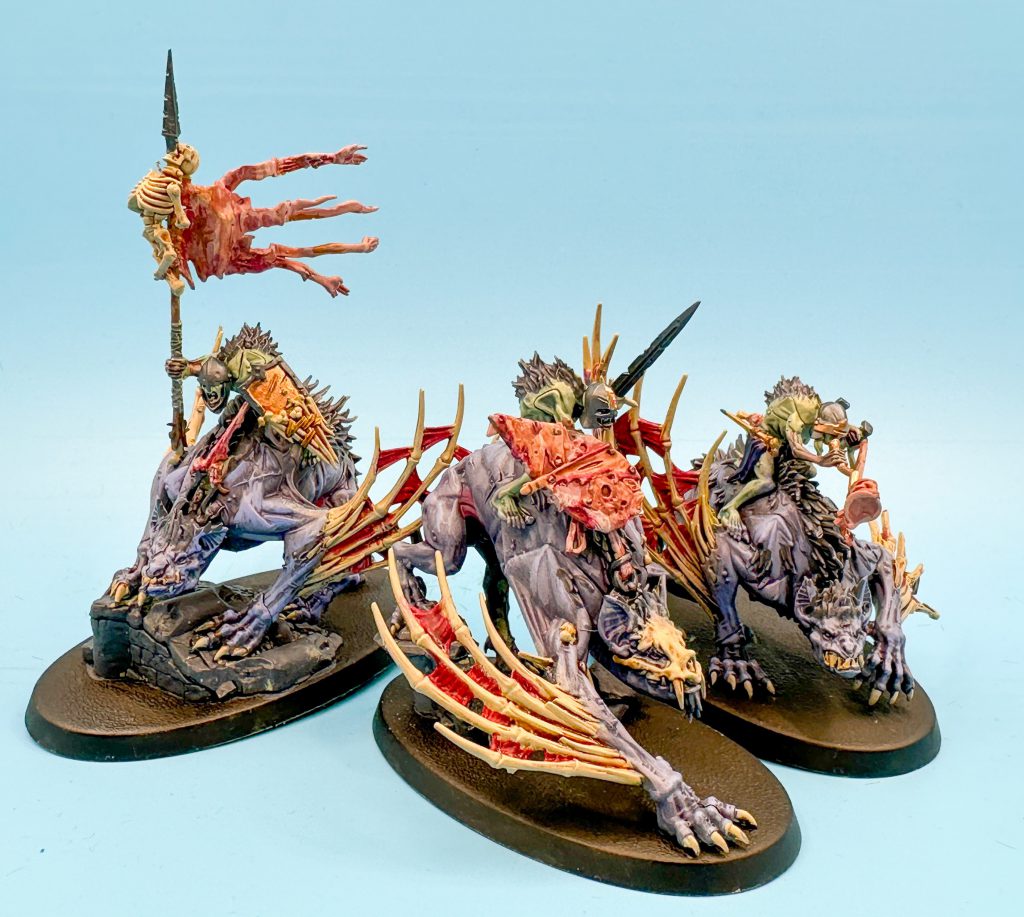
Subfactions
As with every army you get to pick a sub-faction to gain another ability as well as unlocking more choices for battleline in some instances.
Morgaunt
Cryptguard are Battleline and each of your heroes gets a Noble Deed point if it ends the turn contesting an objective. It’s not flashy, but it will add up on most missions, and Cryptguard are great.
Hollowmorne
Crypt Horrors are Battleline and your Knights (but not their mounts) get +1 damage if they charge. This pumps your Morbheg Knights and Crypt Flayers up to Damage 2 and Horrors to a very nasty damage 3. Notable that Horrors are also the cheapest possible battleline option, Hollowmorne will be popular. Playing against them make sure you’re setting up screens so they can’t make the charges they want to.
Blisterskin
Crypt Flayers are Battleline and in a very weird change from before all of your Abhorrants gain the priest keyword (but can’t cast spells and chant a prayer in the same turn). There’s some nice flexibility here, but the prayer lore isn’t that good and the ability has no synergy with Crypt Flayers (in fact, without the Hollowmorne buff they feel a little weak for their cost).
Gristlegore
Your unridden Zombie Dragons and Terrorgheists are Battleline and at the start of your combat phase one monster can strike first. It’s a fall from grace for Gristlegore with the loss of the multiple activations that made this truly disgusting, but if you want to spam the monsters this is still a decent bonus.
Grand Strategies
Not a great selection here, the faction secondaries and tertiaries are definitely a weakness of the tome. Legendary Exploits asks you to have 3 FEC heroes alive each with 6 Noble Deed points when the game ends. Given how much you’re encouraged to spend these for summoning, this requires you to ignore that or to fully refresh some heroes in the last turn.
Expand the Kingdom requires an Abhorrant wholly within enemy territory and your opponent’s general not wholly within their own territory. This is OK, but there will usually still be a generic one you’d prefer.
Defend the Throne is the usual Grand Strat for having no enemy units near your terrain piece, it’s made awkward by the Throne wanting to be set up quite aggressively and also requiring you to be garrisoning it with a FEC hero.
Battle Tactics
Again, this isn’t a fantastic selection, but FEC are pretty good at most GHB-style Battle Tactics anyway. Screamed to Death requires you to kill an enemy unit with the shooting from Flayers, the Infernal Courtier or a Terrorgheist. None of these shooting attacks are particularly reliable, but if you have the units there will usually be a situation with a small unit that can be picked up.
Valiant Slaying is about killing a monster with an Abhorrant. Unlike other versions of this that have popped up over the edition there’s no requirement for the monster to be unharmed when you pick it, so you can feast on an already beaten up monster to pick this up.
Overrun is a potential cheeky late-game pick up, as it requires every enemy unit on the battlefield to finish the turn within 3” of a FEC unit. Glorious Feast is just… extremely restrictive, needinging every friendly unit to be wholly within 12” of a FEC hero that has 6 Noble Deed points. Again, this might be one that’s easier to set up in the late game when armies are smaller and you’re scrounging for Battle Tactics.
Lance Formation is a cool idea: charge with two or more Knight units. That it also requires each charge to be a 7+ makes it a total desperation crapshoot. The Ties of Chivalry is a Tactic for flipping an objective and contesting it with a Serf, Knight and Courtier unit. Requires some setup, but you can at least play for it.
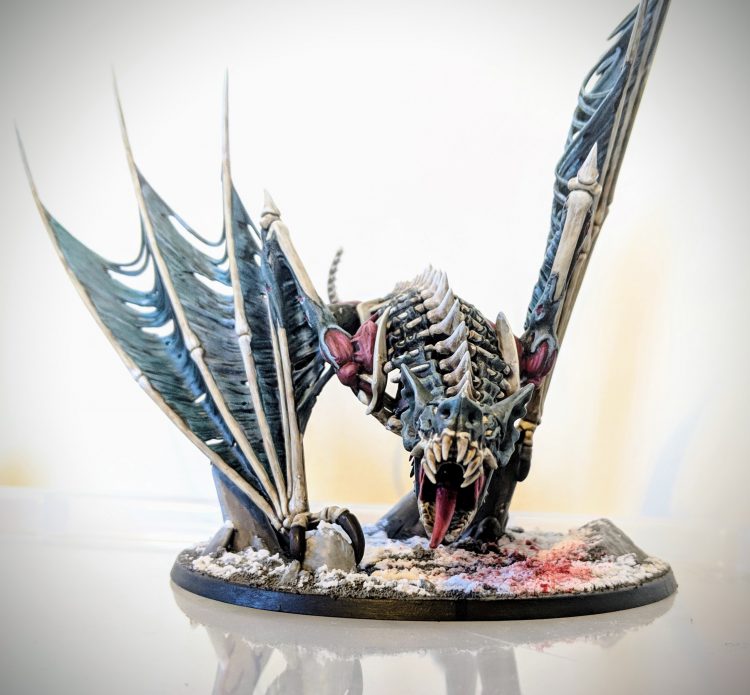
Units
The best lens to view FEC units through is by keyword, rather than battlefield role. Assume that all Abhorrants and Courtiers and heroes and that the only generic battleline is Crypt Ghouls.
Somehow, Nagash returned. The god of death’s warscroll has remained intact, so we’ll just look at him in the context of the army. There’s some bits that work well, and some that don’t. FEC isn’t really an army with a spell lore suited to Nagash’s prowess and some of the units do not interact with his abilities well – Crypt Horrors and Crypt Flayers are both too many wounds to be brought back using Invocation of Nagash and Supreme Lord of the Undead, so they’re out, and Crypt Guard don’t need the ward aura. This means the unit selection the god of death wants to be working with is pretty limited, but it’s worth noting that Morbheg Knights are below the wounds threshold of interacting with Nagash’s abilities, so they can combo with him.
If we look at the major Nagash list archetype that has done well recently, it’s Nagash and his 120 zombie friends. Running a version of this army in FEC is absolutely possible, though ghouls are a little more expensive so it’ll likely not be the full potato horde. Ghouls and Nagash offers less control than the Soulblight version, but is a more aggressive take on the archetype as ghouls are a competent melee threat.
Be aware that Nagash is back to 965 points in this tome – it’s hard to know if this is an intentional hiking of his points back up after they were battlescrolled down again or if this book was just finished a while ago. It’s a shame there isn’t a more elegant solution to having cross-faction characters like this.
Abhorrants
Ushoran is the poster boy for this battletome, and a new Mortarch is always a reason to celebrate, they’re some of the most colourful characters in the realms. The Summerking is a meaty boy, clocking in with 16 wounds and a 5+ ward – though watch out for the 4+ save, Ushoran can’t just be thrown into the thick of the fighting without a care as he will get brought down by a committed enough opponent. He’s a warmaster and a two-spell caster, nice for Noble Deeds, and gets a free 2d3 wound heal in your hero phase. His spell, Glimpse of Delusion, is a bit situational as it picks an enemy within 18” and makes them attack another enemy unit with one of their melee weapons. There will be times this is essentially useless but other times you will make Shadow Queen kill her own army, and that’s priceless.
In melee Ushoran is basically fine, though lacks the rend to really push damage through against other big targets. Mostly you will be bringing him for his utility and he bring a lot of utility to the table. Epicentre of Delusion lets you pick a delusion from the list in the battle traits and apply it in an aura around Ushoran (starting at 30” and degrading down to 12”). The delusions have some big impact abilities in there, and some good situational picks too, so this will pretty much always be useful. Ushoran also extends the range of his own Feeding Frenzy aura out to 24”, turning him into a big walking +1 attack aura and helping to take some of the pressure off of your other heroes so they can focus on spending their points to bring models and units back.
Finally, his Shroudcage Fragment permanently subtracts 1 from the Bravery of enemy units that start the combat phase within 3” of him, then rolls 2d6 against any enemy units within an inch and if you beat their bravery they get strikes last. FEC want to grind, and FEC want their opponents to be failing battleshock, this helps with both of those and will keep Ushoran in the fight. An easy combo here is the Grim Garland artefact on another Abhorrant to get enemies to an immediate -3 Bravery when they get into combat. For 460 points Ushoran brings a lot to the table and is an incredible centrepiece, but he doesn’t do it all by himself.
The Abhorrant Ghoul King on Royal Terrorghist or Royal Zombie Dragon is still kicking around – the vampire on the back now has damage 2 on its melee profile and both monsters are up to 16 wounds, both welcome changes. Zombie Dragons and Terrorgheists both have swingy but potentially powerful melee attacks and respectable shooting, and move a nippy 14” at full bracket. The primary difference really is in the spell the rider is packing. Terrorgheist flavour gets a spell to reroll hits on its fanged maw attack profile (ie the attacks that do 6 mortal wounds on a 6 to hit), whilst the Zombie Dragon version can cast an 18” aura of run and charge for monsters. The result here is that if you’re looking for a solo beatdown monster the Terrorgheist is probably the way to go, but for a monster mash army the Zombie Dragon is a superior utility piece, especially with its mount trait aura.
Your Abhorrant Ghoul King on foot has changed roles a little bit and is now something of an assassin piece – having an ability to give itself +1 damage against an enemy hero at the start of the combat phase. This pulls it up to 5 attacks with damage 3, which isn’t too bad but you might struggle to find a home for it when you start list writing.
On the other hand, the Abhorrant Archregeant is going to be stapled into basically every FEC army, it just does so much. A two spell caster, 7 wounds and a decent attack profile is a good start but the Archregeant also happens to return 3 Serfs or 1 Knight to a unit within 18” of it at the start of the hero phase for absolutely free. This is wonderful for your Noble Deed economy and makes the Archregeant multi-use in how it can bring your models back from the dead. Finally its warscroll spell is really interesting, upon cast you get to give any FEC unit set up on the board in the following movement phase an immediate d6” move. This combos nicely with the Gorewarden, but also just with your basic unit recycling. For 150 points these are a total bargain and expect to see 1-2 in almost every army.
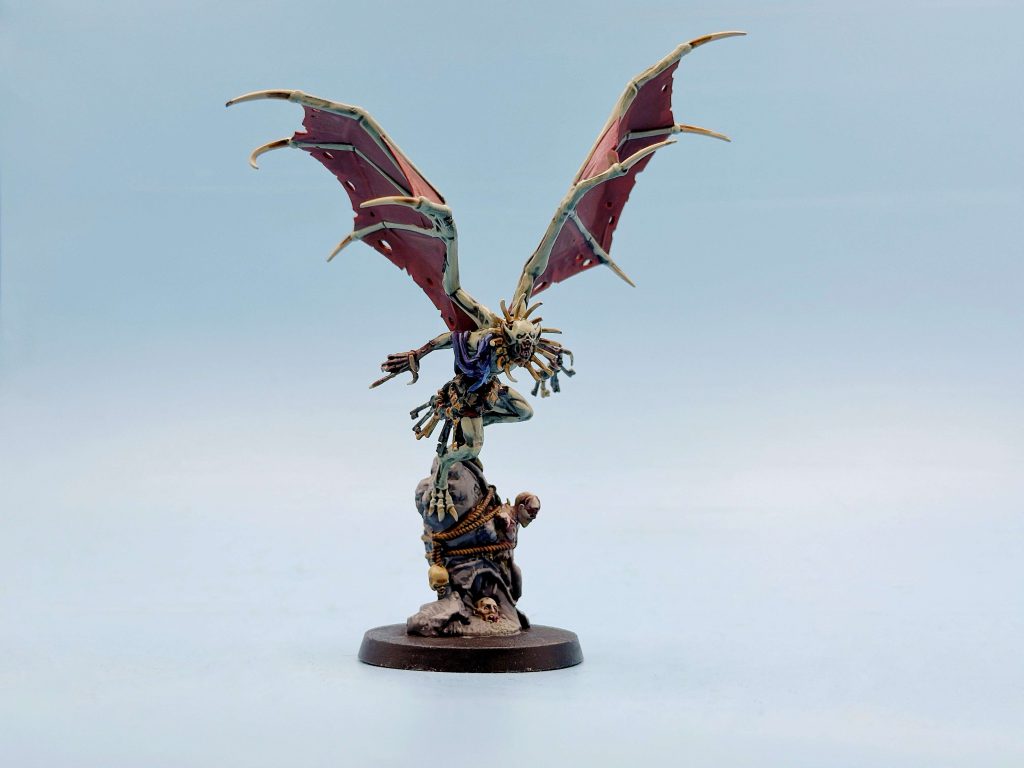
Speaking of the Abhorrant Gorewarden, these are a bit of a mixed bag. They’re 150 points for what is the generic Abhorrant statline (so, fine) with a 12” flying move. They’re a single cast wizard with a teleport spell that allows them to bring another unit that can fly with them. Their other main ability is that they can be set up off the table with a unit of Flayers or Morbheg Knight and then brought down at the end of one of your movement phases, with the usual restrictions. There’s some good utility here, and it’s nice to be able to protect one of your combat units and still have it be able to project threat (especially in concert with the Archregeant spell), but that’s basically all they do, which is a bit of a shame for such an incredible and imposing model.
The Abhorrant Cardinal should be incredibly exciting as the first priest in Death but gets spoiled by the Courtier artefact. Unlike other Abhorrants they’re squishy and terrible in melee so all you get extra over a Courtier priest is its warscroll prayer. That’s an 18” prayer that picks an enemy unit and makes it so every time it receives a command on a 4+ it does nothing. That’s a pretty decent effect, but is competing against the 5+ ward prayer and all the other Abhorrants that just get a bit more done. Still, for 120 points there’s nothing particularly wrong with this warscroll.
Finally we get a brand new named character and an absolute banger of a sculpt. Grand Justice Gormayne is a 10/10 for concept and execution, and you might even run him competitively too. He’s 140 points and gets to Pronounce Judgement in your hero phase, picking one of 4 judgements to apply, each requiring a 3+ roll to activate.
- Petty Transgression – Pick an enemy unit that’s visible (no range!) and your FEC units get +1 to wound it for the rest of the turn. There are other sources of +1 to wound but this is simple and effective.
- Dishonourable Conduct in Battle – Pick an enemy unit more than 3” from all friendly units and your FEC units can run and charge so long as they finish the charge within ½” of the target. Run and charge is huge for your mobility, and is something FEC otherwise have extremely limited access to.
- Grievous Insult to the Court – Pick an enemy unit that is within 3” of an Abhorrant and your FEC units get +1 to hit them. Initially doesn’t seem as sexy as +1 to wound but FEC are full of units that hit on a 4+ and wound on a 3+, so this can quite often be better. It does require the setup of an Abhorrant already being in combat but don’t forget that Ushoran has the Abhorrant keyword and likes a protracted fight.
- Regicide – Pick an enemy unit that has slain an Abhorrant, your FEC units get +1 damage against them. The most situational ability, but really very good when it comes up.
Gormayne is a lot of fun, but do be aware that whilst he is an Abhorrant he doesn’t cast, pray or fight particularly well so the chances of him racking up Noble Deed points outside of the heroic action or terrain feature are basically nil, and that does put a limit on his value.
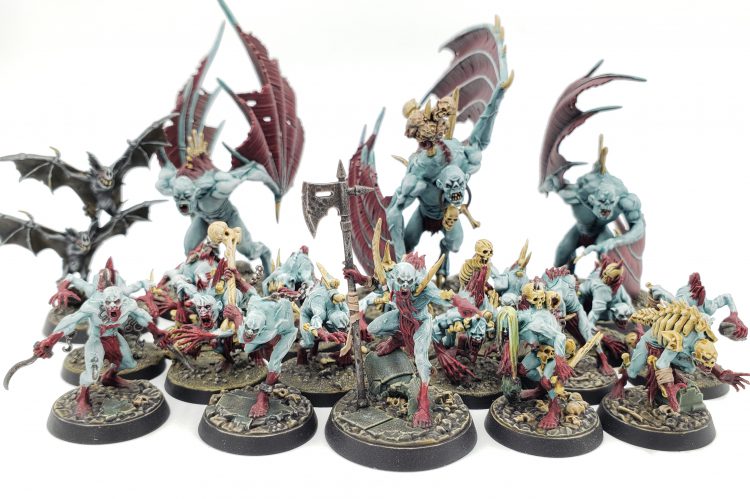
Courtiers
There are two tiers of Courtier available really, three options for a cheap 100 point unit and three more premium choices at varying points. On the cheap end we start with the Marrowscroll Herald, returning with the same warscroll as it had in the Dawnbringer book. We were very cold on this before but the simple presence of the Courtier keyword makes it instantly one of the most compelling options. The bone-offering gimmick is still a gimmick, but it’s ability to become invisible if near 5 other FEC models makes it the most survivable option for sitting at the back.
If you want a cheap Courtier with more offensive potential then the Royal Decapitator gets some rend -2, damage 3 attacks. On top of that it gets to activate a unit of Serfs after it fights, and has a classic 5+ to autokill a hero model ability if it sneaks any damage through. The final bargain basement option is the Crypt Ghast Courtier and this thing really has no reason to exist. With fewer wounds and a worse attack profile than the other 100 pointers, the only ability this has is the exact same one for fighting with a Serf unit that the Decapitator gets. I get that this can’t be the cheapest Courtier, because then it will be taken too often, but they could have at least tried.
For luxury premium Courtiers we have one each that are built from the Horror/Flayer box and interact with the unit they’re based around. The Crypt Haunter Courtier likes to play with Horrors, letting them fight after it does, and is otherwise a beatstick with 5 attacks at rend -2 and damage 3. Hitting on 4s is a shame, but at 140 points it’s a fine option if you’re running a decent amount of Horrors. The Crypt Infernal Courtier gets worse melee but a 10” range shooting attack. It’s 4s to hit and wound, but comes with rend -2 and d3 damage. The buff this brings for Flayers is a staggering +1 damage to their shooting attacks, but only if the Infernal causes damage with its own shooting attack. If it goes off, doubling the damage of your shooting is obviously good, but betting that much on such an unreliable profile just isn’t worth it. This stinks of a gimmick army.
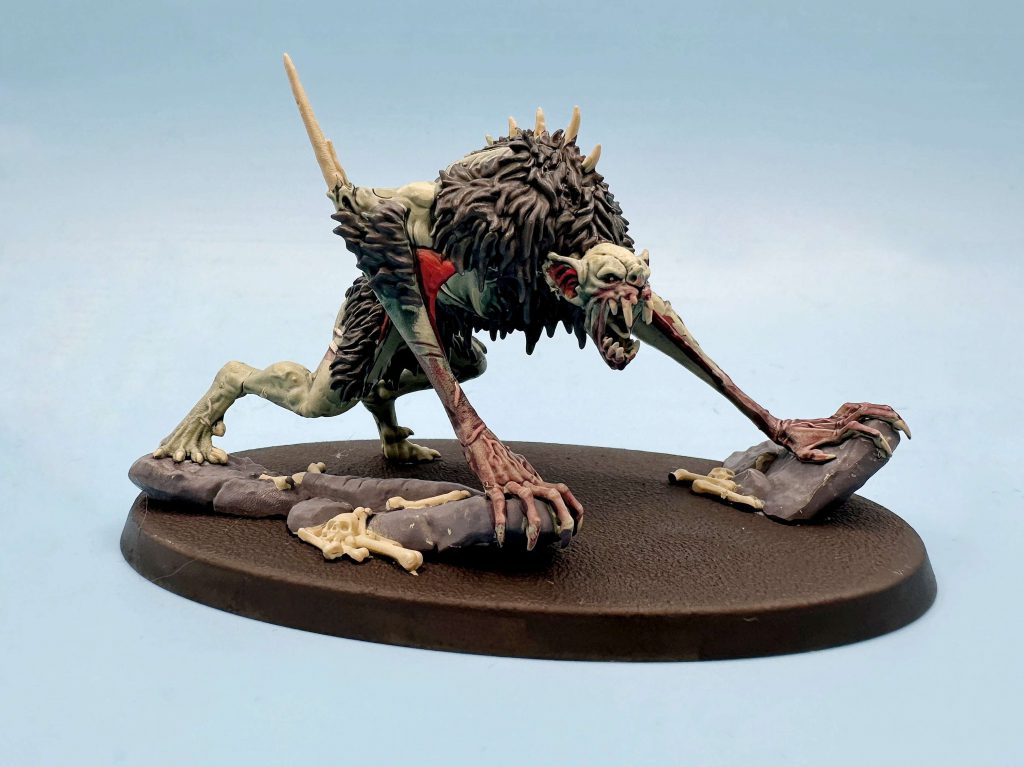
Our final Courtier option is the Varghulf. At 165 points it’s the most expensive option, but it’s also the toughest with 8 wounds and a 4+ save. Otherwise, Varghulfs are quite fast with a 10” move and can pass over terrain as if they fly and their melee profile is just about better than a Haunter, though it takes Feeding Frenzy better with its two weapons.The only other particularly notable rule here is the King’s Champion, which gives the Varghulf +2 attacks against units with a wounds characteristic of 1 or 2. This will make it blend chaff and the like, but I’m not sure that’s what this army needs much help with. It’s a bit of a shame, as smash bat has a rich history of hitting improbably hard, but I’m not sure this does enough to justify being more expensive than any other Courtier or foot-Abhorrant.
Serfs
As the sole generic battleline there’s potentially a lot resting on the shoulders of Crypt Ghouls but thankfully they’re good. At 160 points for a minimum unit size of 20 and access to a lot of ways to bring models and units back puts us in mind of Deadwalker Zombies, a unit that’s done very well for itself. Ghouls offer less control than Zombies in how you can use them, and they don’t blow up when killed, but have a more straightforwardly powerful offensive compatibility. Their 6s to hit automatically wound, and in a unit of 20 or more that becomes 5+s. This does a lot to drag up their mediocre hit and wound numbers (though FEC have ways to buff those too), and they even pick up a pip of rend by standing near a FEC hero, something they want to do anyway. Stack Feeding Frenzy on for an extra base attack and it’s a vicious unit that can also do a fine job screening.
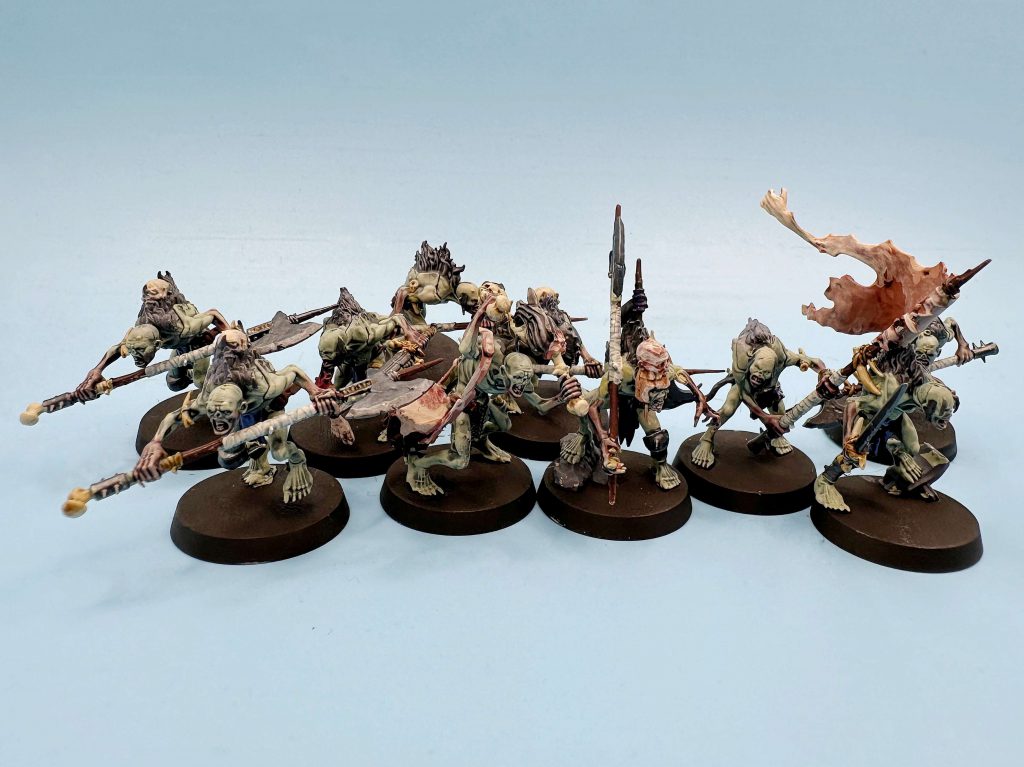
New kids on the block are the Crypt Guard and they’re pretty much what you expect – an elite dual-purpose ghoul unit. 140 points gets you 10 and they come equipped with a 5+ save and 5+ ward, so they’re surprisingly durable with Defenders of the Realm up. In a scrap they have AoS’ most generic attack profile and a really nice ability that stops enemies they damage from being able to receive commands for the rest of the turn. This won’t stop a unit all-out defending itself before the Crypt Guard strike, but it can stop them from using an Inspiring Presence afterwards. With a few ways to manipulate Bravery in the army, this shouldn’t be forgotten about. Finally they have a unique take on the bodyguarding concept a lot of elite units come with, FEC heroes that are wholly within 3” of the Crypt Guard unit enjoy a +1 to their ward save. This makes big units of Crypt Guard a bit unwieldy for protection duty, but being on 25mm bases a 10 can quite comfortably be handing out that +1 ward to your monster heroes – opening up some potential 4+ wards on beefy models.
Fresh off of being involved in everybody’s least favourite summoning rules interaction, Royal Beastflayers are a unit that exists. They don’t hit as hard as other serfs, they aren’t as defensively efficient and their utility is solely restricted to debuffing monsters. Their debuff is good, reducing damage, but you really have to want to take them for that and that alone, especially with no way to make them battleline.
Knights

Morbheg Knights are the new hotness and have probably the most rules of any non-hero warscroll we’ve seen for a while. 150 points gets you 3 models with 3 wounds and a 4+ save. With 5 attacks across 2 weapon profiles they do the most damage of any Knight in melee out of the box, and they benefit the most from Feeding Frenzy too. On top of that you’re looking at a 12” move, fly, a banner that makes each model count as 3 on an objective on the turn that they charge, retreat and charge, impact hits and you can’t use unleash hell on them. Phew! These are hot and the only thing really counting against them is the relatively low wound count for a unit of this type and that the only way to make them battleline is to make the Gorewarden your general, which you have no reason to want to do otherwise.
Crypt Horrors are a solid workhorse of a unit, though with some downsides that need to be worked around. They’re decently punchy with 4 attacks at damage 2 (like Crypt Ghouls, they need to be near a hero to get their rend), and they’re decently tough with 4 wounds – but they also hit on 4s and only get a 5+ save. Where Horrors shine is Hollowmorne: they become the cheapest battleline option for FEC at a svelte 130 points and become an eye-watering damage 3 on the charge. In this format they’re useful as minimum sized filler that will quite happily beat down chaff or as brutal 6-9 strong blocks of beef.
It’s a more complicated story for Crypt Flayers, they share the same defensive profile as horrors but get a 12” flying move. They also get to have rend without requiring any positioning but drop down to a pitiful damage 1 in the process. They’ve got a gimmick to airlift FEC heroes around the board and a shooting attack that is no longer bravery based. There are issues with this unit: the chip shooting is nice and it can be buffed, but those buffs require some luck to set up; they really want to be in Hollowmorne to be able to do any damage at all on the charge, but they’re on battleline in a subfaction they have no synergy with. At 160 for 3 these feel like they’re priced out by Morbheg Knights unless you’re wanting to have some fun and build around a scream list.
Behemoth
The Royal Terrorgheist and Royal Zombie Dragon have had the expected warscroll changes to bring them in line with their Soulblight versions and are therefore decent but unspectacular. If you want to do the monster mash thing it’s better than before – FEC now have a few ways to mitigate some of the perennial issues with these warscrolls (particularly the mount trait aura of +1 to hit). If you’re not doing the monster mash thing, you’re probably not bothering with the unridden monsters.
Endless Spells
Cadaverous Barricade becomes a terrain feature when it’s cast now, which is cool. On top of that it’s a 24” range wall that halves enemy moves and prevents retreats within 3”. For 20 points, this is a genuinely interesting alternative to a triumph bid.
Chalice of Ushoran is yet another bit of admin, if you’re into tracking numbers next to models. For the chalice, you track the number of models slain within 12” and then at the end of the turn roll that many dice and on a 4+ heal a wound on a FEC model within 12” or return a model with 1 wound back to a unit. If you’re running the ghoul horde, this is just another thing to keep your units topped up.
Finally the Corpsemare Stampede is the requisite predatory nuke. It’s 3d6” range is less than ideal, but it does at least move a consistent 12”. For damage you’re rolling 6 dice against any unit it moves over and doing a mortal for each roll that’s greater than their wounds characteristic (or on a 6). Shredding hordes of 1-2 wound models is not something FEC particularly struggles with, so you’re almost certainly better off with one of the utility spells, or a generic one.
Terrain
The Charnel Throne is now garrisonable by one FEC hero with 7 or fewer wounds (sorry, Varghulf) and provides two solid effects. Any hero in the garrison at the start of your hero phase gets d3 Noble Deed points, which is obviously excellent for kick-starting your points – especially on something like the Archregeant that can double cast on top of this.
Secondly the Throne projects a 12” aura that switches off any abilities that allow units to ignore battleshock tests. With the bravery shenanigans you can pull, it’s worth doing what you can to engineer this being set up where you expect the big fights to happen as you want your buff heroes sat inside it and your enemies fleeing before you.

Wonderfully Delusional
This book rules. The redesign of the allegiance abilities are thematic and actually interesting to engage with as the FEC player, asking you to make choices about how you use your heroes. The new range of models are great and really help to convey the theme of the army whilst remaining in keeping with the old sculpts. The book itself is gorgeous in its own special way, and packed with new art and new lore. In terms of play, it’s definitely an aura army and I like the way they’ve pushed the Bravery mechanics. It doesn’t feel like it will be as oppressive as Soulblight and OBR on release, as there are fairly obvious weaknesses built into a lot of what’s on offer here – the army can struggle for rend, often hits on 4s and has low base armour saves, whilst the units themselves don’t have that raw points efficiency of launch Soulblight.
Questions, comments, suggestions, or are you just a delusional courtier? Contact@goonhammer.com, or leave a comment below.


